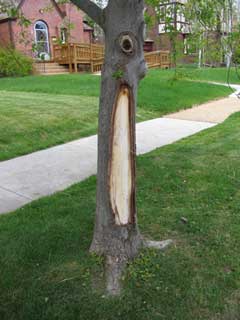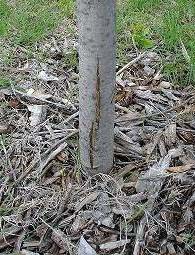| Customer Support |
• |
| Winter Sun Damage Prevention | |
| It is important to provide additional winter protection for the Maples, Locust, Linden, Apple, Crabapple, and Plum species. Until these trees mature and develop a thicker-insulating bark, they remain vulnerable to sun scald and frost cracks. Sun Scald
To reduce or eliminate sun scald injury, wrap the trunks of susceptible trees each fall with tree wrap paper. Do this for one or two seasons until the bark begins to roughen. Remove each spring so as not to provide a home for insects. Tree trunks can also be treated with white latex paint, wrapped with burlap, or a light colored tree guard. Frost CracksOne of the most common reasons for cracks and splits
on tree trunks is cold temperature. These are called frost cracks and are
caused when the inner and outer wood in the tree's trunk expands and
contracts at different rates when temperatures change. This happens when
winter temperatures plummet below zero especially after a sunny day when a
tree's trunk has
Frost cracks often close during summer only to reopen in succeeding winters. They do not seriously hurt trees although they provide openings where certain disease organisms may enter, particularly if the tree is in a weakened condition. Frost cracks are also ideal hiding places for insects which can cause further damage to the weakened tree. Wrapping the trunks of newly planted trees with tree wrap paper in the fall may help avoid frost cracks. As mentioned above, be sure and remove it each spring so as not to provide homes for insects. If damage occurs, simply remove any loose bark hanging along the edges of the crack using a sharp knife to give a clean cut. There is no need to paint the wound with tree paint.*
* Reference- Missouri Botanical Gardens website, see our links page. |
|

 been
warmed by the sun. The different expansion rates between the inner and
outer wood can cause such a strain on the trunk that a crack develops.
Frost cracks occur suddenly, can be several feet long and are often
accompanied by a loud rifle shot sound. They often originate at a point
where the trunk has been physically injured in the past. Isolated
trees and trees growing on poorly drained soils are particularly prone to
frost cracks.
been
warmed by the sun. The different expansion rates between the inner and
outer wood can cause such a strain on the trunk that a crack develops.
Frost cracks occur suddenly, can be several feet long and are often
accompanied by a loud rifle shot sound. They often originate at a point
where the trunk has been physically injured in the past. Isolated
trees and trees growing on poorly drained soils are particularly prone to
frost cracks.